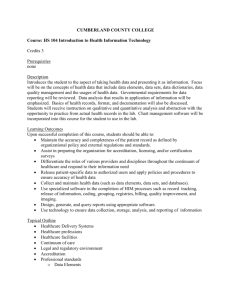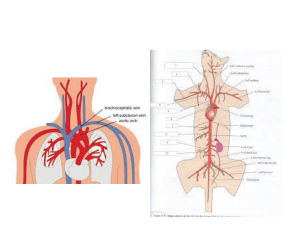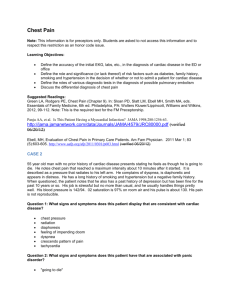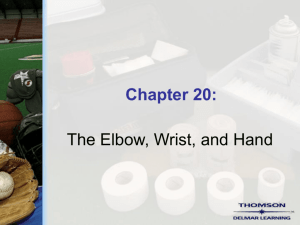Principles of Assessment for EMS by: Bob & Kirsten Elling
advertisement
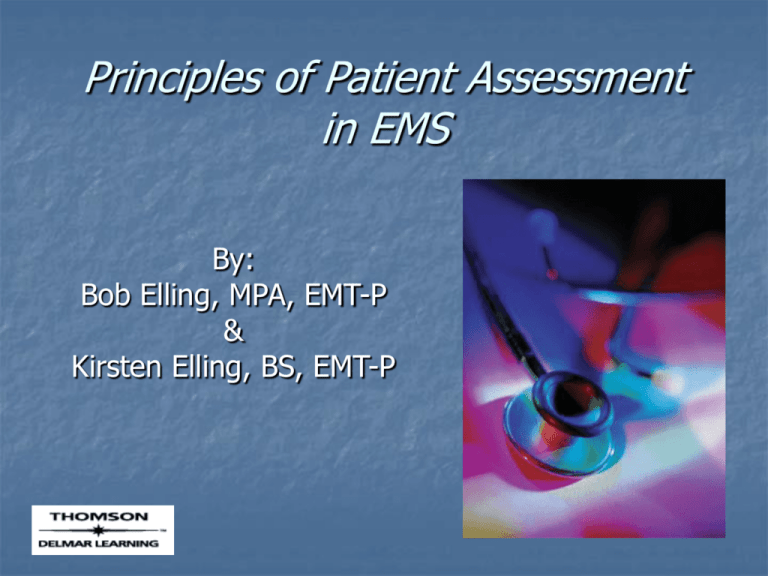
Principles of Patient Assessment in EMS By: Bob Elling, MPA, EMT-P & Kirsten Elling, BS, EMT-P Chapter 13 – Focused History & Physical Exam of the Cardiac Patient © 2003 Delmar Learning, a Division of Thomson Learning, Inc. Objectives Describe the most common cardiovascular chief complaints found in the prehospital setting. Describe why the patient’s history is so important when making a field impression of acute coronary syndrome (ACS). List several ways to ask a patient if he is experiencing chest pain. List several causes of chest pain that are not cardiac related. © 2003 Delmar Learning, a Division of Thomson Learning, Inc. Objectives (continued) Explain why “rule out” is no longer an acceptable term for the EMS provider when making a field impression of a patient. Using OPQRST describe specific information pertaining to the FH of the patient with a CC or chest pain. Using SAMPLE describe specific information pertaining to the FH of the patient with a CC of chest pain. © 2003 Delmar Learning, a Division of Thomson Learning, Inc. Objectives (continued) Describe the significance of JVD in a patient with chest pain. Describe possible abnormal lung sounds that may be detected in a patient with chest pain or dyspnea. Describe the normal heart sounds S1 and S2. Describe the abnormal heart sounds S3 and S4. © 2003 Delmar Learning, a Division of Thomson Learning, Inc. Objectives (continued) Describe the location of the PMI and its significance. List abnormal features found on the chest of a patient with a cardiac history. Describe the locations on the body that the EMS provider may appreciate dependent edema. List the diagnostic tools the EMS provider may use to assess the patient with a possible ACS. © 2003 Delmar Learning, a Division of Thomson Learning, Inc. Objectives (continued) List medications that may cause a syncopal event. Describe the possible findings associated with a silent MI. Describe why dyspnea is a very common symptom associated with MI. List the causes of non-cardiac syncope. © 2003 Delmar Learning, a Division of Thomson Learning, Inc. Introduction Suspicion of an acute coronary syndrome is primarily based on the patient’s history. The PE and use of diagnostic tools are necessary, but a complete history is the most helpful in diagnosing a cardiac problem. © 2003 Delmar Learning, a Division of Thomson Learning, Inc. Introduction The EMS provider treating a patient with ACS needs to work fast and efficiently. Efficiency depends on the EMS provider’s ability to obtain a FH & PE in an effort to recognize less vague conditions such as pneumonia, pleurisy or anxiety reactions. © 2003 Delmar Learning, a Division of Thomson Learning, Inc. The Focused History The FH is a key step in formulating a rational course of treatment. The approach must be orderly to avoid missing important information, possibly leading to less successful outcomes. © 2003 Delmar Learning, a Division of Thomson Learning, Inc. The Focused History (Continued) Interviewing is a tool the EMS provider needs to develop: Be deductive and learn to ask the same question in a variety of ways A patient may deny chest pain but will admit having pressure or discomfort While collecting info, give careful consideration to the obvious symptoms, clinical signs, as well as subtle cues, found in the FH © 2003 Delmar Learning, a Division of Thomson Learning, Inc. The Focused History (continued) Obtain the history of the present illness (HPI) by using the acronym OPQRST, as well as the SAMPLE history. Formulate a field impression (working diagnosis) of the patient’s condition by considering the list of potential causes of the chest pain. Listen carefully to the patient and note the level of distress. © 2003 Delmar Learning, a Division of Thomson Learning, Inc. Focused History (continued) The EMS provider does not do a specific ACS, rather he begins to differentiate the info obtained. In most cases the patient interview is conducted simultaneously with the PE. Consider that pain anywhere from the navel to the jaw is cardiac ischemia until proven otherwise. © 2003 Delmar Learning, a Division of Thomson Learning, Inc. Focused History (continued) Not all patients have “substernal” chest pain when experiencing ACS (i.e.: women, elderly, and diabetics). They may complain of feeling weak, have mild dyspnea or “just do not feel right” when experiencing an ACS. © 2003 Delmar Learning, a Division of Thomson Learning, Inc. Focused History (continued) O – How did the symptom begin? P – What was the patient doing at the time of onset? Q – Have the patient describe the type of pain in his own words. R – Ask the patient to point to the location of the pain. S – Compare to a similar experience or on a scale of 1 to 10. T – How long has the symptom been present? © 2003 Delmar Learning, a Division of Thomson Learning, Inc. Focused History (continued) S – symptoms associated with ACS may include: Chest pain, pressure, tightness, squeezing, heartburn, palpations Radiating pain to stomach, arm, neck, jaw, or back Shortness of breath Indigestion, nausea, vomiting, dizziness, lightheaded Anxiety, a feeling that something is wrong Weakness, fatigue, AMS, near fainting or syncope Sweating (diaphoresis) Tingling or numbness Swelling of the feet, legs, hands (peripheral edema) © 2003 Delmar Learning, a Division of Thomson Learning, Inc. Focused History (continued) A – do you have any allergies to med? M – do you take any prescribed, OTC, homeopathic, herbal, of recreational drugs? P – ask about pertinent PMH like: heart condition, pacemaker, CABG, stent, breathing problems, last Dr. visit, etc? L – what was you last oral intake? E – any exertional or non-exertional events leading up to symptoms? © 2003 Delmar Learning, a Division of Thomson Learning, Inc. Physical Exam Assess mental status Suspect cardiac related conditions if any of the following are discovered during the IA: AMS – may indicate decreased perfusion due to poor cardiac output Skin CTC – pale or diaphoretic due to shock ABCs – dyspnea, abnormal breathing patterns, or adventitious breath sounds Abnormal distal pulses: weak or absent, unequal, irregular, tachycardia, or bradycardia © 2003 Delmar Learning, a Division of Thomson Learning, Inc. Physical Exam (continued) Focus on the cardiovascular and respiratory systems. Assess head-to-toe Look at the neck to assess for presence of JVD (45 degree angle) Listen to lung sounds, heart sounds, inspect and palpate the chest and abdomen Reassess the respiratory rate and breathing pattern © 2003 Delmar Learning, a Division of Thomson Learning, Inc. Physical Exam (continued) Listen to heart sounds The normal sounds are S-1 and S-2 or the “lub-dub” sound S-1 is the first sound and is produced by the AV valves during ventricular contraction S-2 is the second sound and is produced during ventricular diastole Abnormal sounds are extra sounds (ie: S-3, S-4, murmurs, gallops and clicks) To listen for heart sounds place the bell of the stethoscope lightly over the point of maximal impulse (PMI) on the left anterior chest at the 5th intercostal space and the midclavicular line © 2003 Delmar Learning, a Division of Thomson Learning, Inc. Physical Exam (continued) Visually inspect and palpate the chest and abdomen noting the presence of: Surgical scars (ie: pacemakers, defibrillators, cardiac and abnormal surgeries) Transdermal patches Distension from bloating, ascites or dependent edema Pain reproducible with movement or not Tenderness, masses, and pulsations Location of the PMI Peripheral edema © 2003 Delmar Learning, a Division of Thomson Learning, Inc. Diagnostic Tools Primary components are utilized with diagnosis of an MI: Medical history including CC or primary symptom ECG analysis Cardiac enzyme analysis An ECG abnormality alone does not diagnose or exclude an AMI, but can be helpful to guide treatment. © 2003 Delmar Learning, a Division of Thomson Learning, Inc. Diagnostic Tools (continued) When an MI is occurring a 12 lead ECG may help to identify the location of ischemia or infarct. Additional diagnostic tools include: Pulse oximetry Capnography Baseline & serial VS Orthostatic changes Blood test Troponin, myosin, CK-MB over 12-24 hours © 2003 Delmar Learning, a Division of Thomson Learning, Inc. Features of Chest Pain Can be caused by many disease processes, as well as ACS To help determine origin of chest pain focus on the following key points: Onset Duration Precise quality of pain Radiation Associated findings © 2003 Delmar Learning, a Division of Thomson Learning, Inc. Features of Chest Pain (continued) Classic pain from AMI is often described as “heaviness or squeezing” or a sudden painful sensation of pressure. May radiate to arms, shoulders, neck or back and usually last more than 20 minutes Associated signs/symptoms may include: Sweating Nausea/vomiting Anxiety No position of comfort Levine’s sign © 2003 Delmar Learning, a Division of Thomson Learning, Inc. Features of Chest Pain (continued) Chest pain that changes intensity with positioning or breathing may be associated with pleurisy, pneumothorax, pericarditis, pneumonia, or musculoskeletal problems. Any condition that causes inflammation of the lungs or heart can extend to the pleural surfaces of the lung and produce chest pain. This is called pleuritic pain. Associated signs for pleuritic pain include: infection, elevated temperature, chills, increased sputum or coughing. © 2003 Delmar Learning, a Division of Thomson Learning, Inc. Features of Chest Pain (continued) Patients with limited mobility are at increased risk for aspiration, pneumonia, and respiratory infection. Pain described as a “tearing” sensation in the chest or abdomen or back is suggestive of an AAA. The “silent MI” is a significant number of patients who do not have typical MI symptoms. The elderly, women, diabetics, or patients with neuropathic conditions experience MI with atypical and subtle symptoms. © 2003 Delmar Learning, a Division of Thomson Learning, Inc. Features of Chest Pain (continued) Atypical symptoms include: AMS or syncope Weakness or fatigue Dyspnea – mild to severe exertional Epigastric, back or neck pain Shortness of breath especially in the elderly or diabetic may be the primary or only symptom of AMI or acute heart failure Shortness of breath, exertional dyspnea, and paroxysmal nocturnal dyspnea (PND) strongly suggests a cardiac problem © 2003 Delmar Learning, a Division of Thomson Learning, Inc. Features of Chest Pain (continued) CHF and acute exacerbation of COPD are often difficult to differentiate. Look for a history of heart failure and any of the following: SOB with or without pink tinged sputum Presence of JVD Peripheral edema Chest discomfort Cardiac dysrhythmias Inspiratory rales/crackles in the lungs Diuretic medications or recent medication changes © 2003 Delmar Learning, a Division of Thomson Learning, Inc. Syncope In the elderly may be the only clinical sign of a cardiac problem. Cardiac causes of syncope include: Heart blocks Dysrhythmias (bradycardia, blocks, SVTs, StokesAdams Syndrome, Sick Sinus Syndrome) Aortic stenosis, AMI, and angina Non-Cardiac causes of syncope include: Orthostatic or postural hypotension Medications Vasovagal faint Vasodepressor syncope © 2003 Delmar Learning, a Division of Thomson Learning, Inc. Syncope (continued) Ask about pre and post syncope information such as: Position of the patient Chest pain or palpitations Dyspnea Dizzyness or weakness Any similar events Duration of loss of consciousness (LOC) © 2003 Delmar Learning, a Division of Thomson Learning, Inc. Syncope (continued) Duration of LOC is a helpful clue: Cardiac and neurologic syncope usually occur without warning. Recovery is often slow with confusion, headache, dizziness, orthostatic changes or local dysfunction Non-Cardiac syncope often occurs in patients without a PMH. Usually caused by a stressor such as pain, emotion or medication and last briefly with a quick recovery period © 2003 Delmar Learning, a Division of Thomson Learning, Inc. Conclusion Utilize the standardized approach to assess the patient with cardiac problems. Recognize cardiac related symptoms, obtain a FH and perform an appropriate PE. Many etiologies of chest pain are difficult to differentiate. The Hx is the most important factor in making a field impression of ACS. Formulate a field impression from the FH, OPQRST and SAMPLE. Be alert for subtle clues, as well as obvious clinical signs & symptoms. © 2003 Delmar Learning, a Division of Thomson Learning, Inc.
